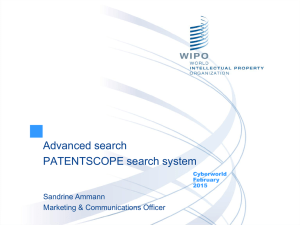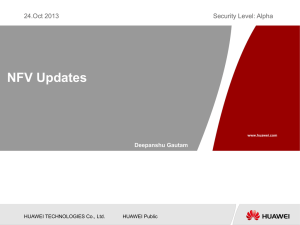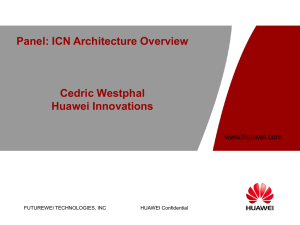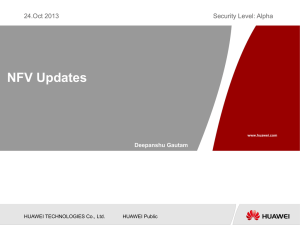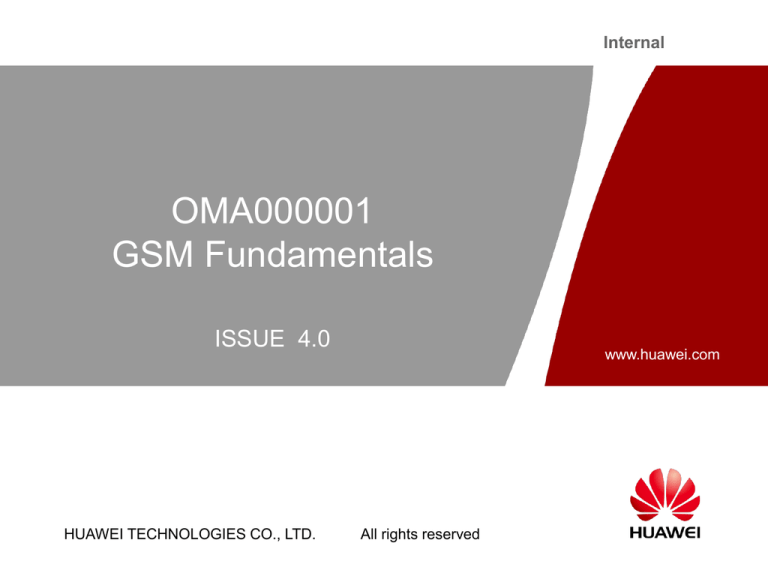
Internal
OMA000001
GSM Fundamentals
ISSUE 4.0
HUAWEI TECHNOLOGIES CO., LTD.
www.huawei.com
All rights reserved
Upon completion of this course, you will be able to:
Grasp basic idea of GSM system such as
frequency spectrum, frequency reuse etc.
Grasp the structure of the GSM system and the
protocol used.
Grasp certain numbers that refer to BSS
Grasp the 4 kinds of channel combination and
understand the idea of multi-frame.
Know some radio techniques
Get the idea of EDGE
HUAWEI TECHNOLOGIES CO., LTD.
All rights reserved
Page 2
References
BSS Feature Description
BSS Signaling Analysis Manual
BSC Technical Manual
HUAWEI TECHNOLOGIES CO., LTD.
All rights reserved
Page 3
Chapter 1 GSM System Overview
Chapter 2 GSM Network Structure
Chapter 3 Service Area and Number Planning
Chapter 4 Channels on the Wireless Interface
Chapter 5 Radio Techniques
Chapter 6 GPRS & EDGE Introduction
HUAWEI TECHNOLOGIES CO., LTD.
All rights reserved
Page 4
GSM system overview
The GSM system is a frequency- and time-division cellular system,
each physical channel is characterized by a carrier frequency and a
time slot number
Cellular systems are designed to operate with groups of low-power
radios spread out over the geographical service area. Each group of
radios serve MSs presently located near them. The area served by
each group of radios is called a CELL
Uplink and downlink signals for one user are assigned different
frequencies, this kind of technique is called Frequency Division Duplex
(FDD)
Data for different users is conveyed in time intervals called slots ,
several slots make up a frame. This kind of technique is called Time
Division Multiple Access (TDMA)
HUAWEI TECHNOLOGIES CO., LTD.
All rights reserved
Page 5
GSM Development
1989
Standard Protocol for GSM take effect
1991
GSM system began to provide service in Europe(2G)
1992
System was named as Global System for
Mobile Communication
1994
Provide services for the whole world
1996
Micro Cell Technique is used in GSM system
HUAWEI TECHNOLOGIES CO., LTD.
All rights reserved
Page 6
Cell Technique
Macro Cell and Micro Cell
A certain radio coverage area formed by a set of transceivers that
connected to a set of antennas is called a CELL.
Macro Cell
In the beginning , High-Power BTSs are adopted to provide services.
The BTS covers a wider area , but its frequency utilization is not
efficient. So , it can only provide a few channels for subscribers.
Micro Cell
Later the Low-Power BTS joins the system for getting a better service
area with high capacity . At the same time it adopts the frequency
reuse technique to improve the efficiency of the frequency utilization
and also the whole capacity of the network.
HUAWEI TECHNOLOGIES CO., LTD.
All rights reserved
Page 7
Multiple Access Technique
Multiple Access Technique allows many subscribers to use the
same communication medium.
There are three kinds of basic Multiple Access Technique :
FDMA , TDMA and CDMA.
GSM system adopt FDD-TDMA (FDMA and TDMA together).
HUAWEI TECHNOLOGIES CO., LTD.
All rights reserved
Page 8
FDMA
FDMA uses different frequency
channels to accomplish
communication.
Frequency
The whole frequency spectrum
available is divided into many
individual channels (for
transmitting and receiving),every
channel can support the traffic for
one subscriber or some control
information.
Time
HUAWEI TECHNOLOGIES CO., LTD.
All rights reserved
Page 9
TDMA
TDMA accomplishes the
communication in different
timeslot.
Frequency
A carrier is divided into
Time
HUAWEI TECHNOLOGIES CO., LTD.
channels based on time.
Different signals occupy
different timeslots in certain
sequence , that is , many
signals are transmitted on
the same frequency in
different time.
All rights reserved
Page 10
CDMA
CDMA accomplishes the
communication in different
code sequences.
Frequency
Special coding is adopted
Time
HUAWEI TECHNOLOGIES CO., LTD.
before transmission, then
different information will
lose nothing after being
mixed and transmitted
together on the same
frequency and at the
same time.
All rights reserved
Page 11
The Frequency Spectrum
GSM 900
Uplink
890
Downlink
915
935
Duplex Separation:
Channel Bandwidth:
HUAWEI TECHNOLOGIES CO., LTD.
All rights reserved
960MHz
45MHz
200KHz
Page 12
The Frequency Spectrum
DCS 1800
Base Station Receive
1710
Base Station Transmit
1785 1805
Duplex Separation:
Channel Bandwidth:
HUAWEI TECHNOLOGIES CO., LTD.
All rights reserved
1880MHz
95MHz
200KHz
Page 13
The Frequency Spectrum
Frequency
Point
Available
Frequency
Spectrum
Range (MHz)
GSM 450
450.4~457.6
460.4~467.6
Fu(n)=450.6+0.2(n-259)
259<=n<=293
Fd(n)=Fu(n)+10
GSM 480
478.8~486
488.8~496
Fu(n)=479+0.2(n-306)
306<=n<=340
Fd(n)=Fu(n)+10
GSM 850
824~849
869~894
Fu(n)=824.2+0.2(n-128)
128<=n<=251
Fd(n)=Fu(n)+45
E-GSM 900
880~915
925~960
Fu(n)=890+0.2n
Fu(n)=890+0.2(n-1024)
0<=n<=124
975<=n<=1023
Fd(n)=Fu(n)+45
R-GSM 900
876~915
921~960
Fu(n)=890+0.2n
Fu(n)=890+0.2(n-1024)
0<=n<=124
955<=n<=1023
Fd(n)=Fu(n)+45
PCS 1900
1850~1910
1930~1990
Fu(n)=1850.2+0.2(n-512)
512<=n<=810
Fd(n)=Fu(n)+80
Uplink Frequency
HUAWEI TECHNOLOGIES CO., LTD.
All rights reserved
Page 14
Downlink
Frequency
Frequency Reuse
The frequency resource of mobile system is very limited.
The different Subscribers can use the same frequency in
different places.
The quality of communication must be ensured.
HUAWEI TECHNOLOGIES CO., LTD.
All rights reserved
Page 15
Frequency Reuse
7(Site)X 1(Cell) reuse
2
7
23
1
6
4
5
HUAWEI TECHNOLOGIES CO., LTD.
All rights reserved
Page 16
Frequency Reuse
1
5
3
7
11
9
8
6
2
10
4
12
R
4 site X 3 cells reuse
HUAWEI TECHNOLOGIES CO., LTD.
All rights reserved
Page 17
Cell Types
Omni
Omni-directional Cell
1
1
120
degree
120 Degree Cell
3
HUAWEI TECHNOLOGIES CO., LTD.
All rights reserved
Page 18
2
Chapter 1 GSM System Overview
Chapter 2 GSM Network Structure
Chapter 3 Service Area and Number Planning
Chapter 4 Channels on the Wireless Interface
Chapter 5 Radio Techniques
Chapter 6 GPRS & EDGE Introduction
HUAWEI TECHNOLOGIES CO., LTD.
All rights reserved
Page 19
GSM-GPRS Network Component
MSC/VLR
PSTN
ISDN
GMSC
GSM /GPRS BSS
BSC
MS
HLR/AUC
BTS
PCU
SS7
BSC
SMS system
MS
BTS
Internet,
Intranet
GPRS Backbone
SGSN
GGSN
OMC
CG
BG
Other PLMN
HUAWEI TECHNOLOGIES CO., LTD.
All rights reserved
Page 20
Interface Between Different Entities
MSC/VLR
PSTN
ISDN
GMSC
GSM /GPRS BSS
Abis
MS
A
BSC
HLR/AUC
BTS
C/D/Gs
PCU
SS7
Gb
BSC
MS Um
SMS system
Gr/Gs/Gd/Ge
Gc
BTS
GPRS backbone
SGSN
Gi
GGSN
Ga
OMC
CG
BG
Gp
HUAWEI TECHNOLOGIES CO., LTD.
All rights reserved
Internet,
Intranet
Page 21
Other PLMN
Mobile Station—MS
MS=ME+SIM
International Mobile Equipment Identity (IMEI)
– Mobile Equipment
International Mobile Subscriber Identity (IMSI)
– Subscriber Identity Module
HUAWEI TECHNOLOGIES CO., LTD.
All rights reserved
Page 22
Subscriber Identity Module – SIM
International Mobile Subscriber Identity
(IMSI)
SIM
Temporary Mobile Subscriber Identity (TMSI)
Location Area Identity (LAI)
Subscriber Authentication Key (Ki)
HUAWEI TECHNOLOGIES CO., LTD.
All rights reserved
Page 23
Base Station Subsystem – BSS
MSC
The Base Station Controller –
BSC
BSS
The Base Transceiver Station
– BTS
The Trans-coder – TC and
Sub multiplexer (SM)
TC/SM
BSC
BTS
HUAWEI TECHNOLOGIES CO., LTD.
All rights reserved
Page 24
Packet Control Unit-----PCU
MSC
Packet data
switching
Bridge between
SGSN and BSC
Provide Pb and
BSS
TC/SM
GPRS
Backbone
Gb interface
BSC
PCU
BTS
HUAWEI TECHNOLOGIES CO., LTD.
All rights reserved
Page 25
SGSN
The Network Switching System
AUC
HLR
EIR
NSS
OMC
EC
MSC/VLR
Mobile-service Switching Center
Home Location Register
Visitor Location Register
Equipment Identity Register
Authentication Center
Echo Cancellor
HUAWEI TECHNOLOGIES CO., LTD.
– MSC
– HLR
– VLR
– EIR
– AUC
– EC
All rights reserved
BSS
Page 26
PSTN
Mobile-service Switching Center – MSC
Call Processing
Operations and Maintenance Support
Interface management
Inter-network & Inter-working
Billing
HUAWEI TECHNOLOGIES CO., LTD.
All rights reserved
Page 27
Home Location Register – HLR
Subscriber ID (IMSI and MSISDN)
Current subscriber VLR (current location)
Supplementary service information
Subscriber status (registered/deregistered)
Authentication key and AuC functionality
HUAWEI TECHNOLOGIES CO., LTD.
All rights reserved
Page 28
Visitor Location Register – VLR
Mobile Status (IMSI attached / detached / busy / idle etc.)
Location Area Identity(LAI)
Temporary Mobile Subscriber Identity(TMSI)
Allocating the Roaming Number
HUAWEI TECHNOLOGIES CO., LTD.
All rights reserved
Page 29
Equipment Identity Register – EIR
White List
Black List
IMEI is Checked In White List
Grey List
If NOT found
EIR focus on the
equipment , not the
subscriber!!
HUAWEI TECHNOLOGIES CO., LTD.
IMEI is Checked in Black/Grey List
All rights reserved
Page 30
OMC Functional Architecture
Security
Management
Event/Alarm
Management
MMI
OS
DB
Fault
Management
Configuration
Management
Performance
Management
HUAWEI TECHNOLOGIES CO., LTD.
All rights reserved
Page 31
Chapter 1 GSM System Overview
Chapter 2 GSM Network Structure
Chapter 3 Service Area and Number Planning
Chapter 4 Channels on the Wireless Interface
Chapter 5 Radio Techniques
Chapter 6 GPRS & EDGE Introduction
HUAWEI TECHNOLOGIES CO., LTD.
All rights reserved
Page 32
Service Area
Service Area
PLMN
PLMN service
service area
area
MSC service area...
PLMN service area
MSC service area...
Location area...
Location area...
cell
cell
HUAWEI TECHNOLOGIES CO., LTD.
All rights reserved
Page 33
......
LAI
MCC
MNC
LAC
Location Area Identification
The LAI is the international code for a location area.
MCC: Mobile Country Code,It consists of 3 digits .
For example: The MCC of China is "460"
MNC: Mobile Network Code,It consists of 2 digits .
For example: The MNC of China Mobile is "00"
LAC: Location Area Code,It is a two bytes hex code.
The value 0000 and FFFF is invalid.
For example: 460-00-0011
HUAWEI TECHNOLOGIES CO., LTD.
All rights reserved
Page 34
CGI
CGI: Cell Global Identification
The CGI is a unique international identification for a cell
The format is LAI+CI
LAI: Location Area Identification
CI: Cell Identity. This code uses two bytes hex code to
identify the cells within an LAI.
For example : 460-00-0011-0001
HUAWEI TECHNOLOGIES CO., LTD.
All rights reserved
Page 35
BSIC
BSIC(Base Station Identification Color Code)
NCC
BCC
BSIC
NCC: PLMN network color code. It comprises 3 bit. It
allows various neighboring PLMNs to be
distinguished.
BCC: BTS color code. It comprises 3 bit, used to
distinguish different cells assigned the same
frequency!
HUAWEI TECHNOLOGIES CO., LTD.
All rights reserved
Page 36
MSISDN
CC
NDC
SN
National (significant)
Mobile number
Mobile station international
ISDN number
CC: Country Code. For example: The CC of China is "86".
NDC: National Destination Code. For example: The NDC of
China Telecom is 139, 138, 137, 136, 135.
SN: Subscriber Number. Format:H0 H1 H2 H3 ABCD
Example: 86-139-0666-1234
HUAWEI TECHNOLOGIES CO., LTD.
All rights reserved
Page 37
IMSI
Not more than 15 digits
3 digits
2 digits
MCC
MNC
MSIN
NMSI
IMSI
MCC: Mobile Country Code,It consists of 3 digits .
For example: The MCC of China is "460"。
MNC: Mobile Network Code,It consists of 2 digits .
For example: The MNC of China Telecom is "00"。
MSIN: Mobile Subscriber Identification Number. H1H2H3 S ABCDEF
For example: 666-9777001
NMSI: National Mobile Subscriber Identification,MNC and MSIN
form it together.
For Example of IMSI : 460-00-666-9777001
HUAWEI TECHNOLOGIES CO., LTD.
All rights reserved
Page 38
TMSI
TMSI: Temporary Mobile Subscriber Identification)
The TMSI is assigned only after successful subscriber
authentication.
The VLR controls the allocation of new TMSI numbers and notifies
them to the HLR.
TMSI is used to ensure that the identity of the mobile subscriber
on the air interface is kept secret.
The TMSI consists of 4 bytes( 8 HEX numbers) and determined by
the operator.
HUAWEI TECHNOLOGIES CO., LTD.
All rights reserved
Page 39
IMEI
IMEI: International Mobile Station Equipment Identification
TAC
FAC
SNR
SP
IMEI
TAC: Type approval code, 6 bit, determined by the type approval center
FAC: Final assembly code, 2 bit, It is determined by the manufacturer.
SNR: Serial number, 6 bits, It is issued by the manufacturer of the MS.
SP: 1 bit , Not used.
Check the IMEI in your MS : *#06#
HUAWEI TECHNOLOGIES CO., LTD.
All rights reserved
Page 40
Chapter 1 GSM System Overview
Chapter 2 GSM Network Structure
Chapter 3 Service Area and Number Planning
Chapter 4 Channels on the Wireless Interface
Chapter 5 Radio Techniques
Chapter 6 GPRS & EDGE Introduction
HUAWEI TECHNOLOGIES CO., LTD.
All rights reserved
Page 41
Physical Channel and Logical Channel
The physical channel is the medium over which the
information is carried: 200KHz and 0.577ms
The logical channel consists of the information carried
over the physical channels
0
1 2
Timeslot
3 4
5 6
7 0
1 2
3
The information carried in one time
slot is called a “burst”
TDMA FRAME
HUAWEI TECHNOLOGIES CO., LTD.
All rights reserved
TDMA FRAME
Page 42
Two types of Logical Channel
Traffic Channel (TCH) :
Transmits traffic information, include data
and speech.
Control Channel (CCH) :
Or Signaling Channel, transmits all kinds of
control information.
HUAWEI TECHNOLOGIES CO., LTD.
All rights reserved
Page 43
Traffic Channel (TCH)
TCH
Traffic Channels
Speech
TCH/FS
TCH/HS
Data
TCH/9.6
TCH Traffic Channel
TCH/FS Full rate Speech Channel
TCH/HS Half rate Speech Channel
TCH/9.6 Data Channel 9.6kb/s
TCH/4.8 Data Channel 4.8kb/s
TCH/2.4 Data Channel 2.4Kb/s
HUAWEI TECHNOLOGIES CO., LTD.
TCH/2.4
TCH/4.8
All rights reserved
Page 44
Control Channel (CCH)
CCH (Control Channels)
DCCH
SDCCH
FACCH
BCH
ACCH
BCCH
SACCH
HUAWEI TECHNOLOGIES CO., LTD.
CCCH
SCH
Broadcast Control Channel – BCCH
Common Control Channel – CCCH
Dedicated Control Channel – DCCH
Associated Control Channel – ACCH
Synch. CH.
RACH
CBCH
PCH/AGCH
All rights reserved
Page 45
FCCH
Broadcast Control Channel – BCCH
CCH
The information carried on the BCCH
is monitored by the MS
BCH
periodically when it is in idle mode
BCCH: Broadcast Control Channel
FCCH: Frequency Correction Channel
BCCH
Synch.
Channels
SCH
FCCH
SCH: Synchronization Channel
HUAWEI TECHNOLOGIES CO., LTD.
All rights reserved
Page 46
Common Control Channel – CCCH
CCH
The CCCH is responsible for
transferring control information
between all mobiles and the
network.
CCCH
RACH: Random Access Channel
PCH: Paging Channel
AGCH: Access Granted Channel
CBCH: Cell Broadcast Channel
RACH
uplink
CBCH
downlink
PCH/AGCH
downlink
HUAWEI TECHNOLOGIES CO., LTD.
All rights reserved
Page 47
Dedicated Control Channel – DCCH
CCH
DCCH is assigned to a single
wireless connection for
measurement and handover
purpose.
SDCCH: Stand-alone Dedicated
Control Channel
ACCH: Associated Control Channel
SACCH: Slow Associated
Control Channel
FACCH: Fast Associated Control
Channel
DCCH
SDCCH
FACCH
HUAWEI TECHNOLOGIES CO., LTD.
All rights reserved
Page 48
ACCH
SACCH
Uplink Logical channel
CCH
RACH
CCCH
SDCCH
SACCH
DCCH
DCH
FACCH
TCH/F
TCH/H
HUAWEI TECHNOLOGIES CO., LTD.
All rights reserved
TCH
Page 49
Downlink Logical channel
FCCH
CCH
BCCH
SCH
BCCH
CCCH
PCH
AGCH
SDCCH
DCH
DCCH
SACCH
FACCH
TCH
TCH/F
TCH/H
HUAWEI TECHNOLOGIES CO., LTD.
All rights reserved
Page 50
How to use these channels?
Power-off
Search for frequency correction burst
FCCH
SCH
BCCH
Search for synchronous burst
Extract system information
Idle mode
Monitor paging message
PCH
RACH
AGCH
SDCCH
SDCCH
TCH
FACCH
Send access burst
Allocate signaling channel
Dedicated mode
Set up the call
Allocate voice channel
Conversation
Idle mode
HUAWEI TECHNOLOGIES CO., LTD.
Release the call
All rights reserved
Page 51
Packet logic channel
TCH
Packet data channel (PDCH)
Comprising packet service channel and packet control channel
TCH
Packet service channel (PDTCH)
Combined into the single-directional service channel
BCCH
CCCH
Packet control channel
SACCH
Broadcast control channel: PBCCH
Public control channel: PPCH, PRACH, PAGCH
Private control channel: PACCH, PTCCH
HUAWEI TECHNOLOGIES CO., LTD.
All rights reserved
Page 52
GSM Logical Channel Combination
Main BCCH combination – FCCH + SCH + BCCH + CCCH
SDCCH combination – SDCCH/8 + SACCH/8
Combined BCCH – BCCH + CCCH +SDCCH/4 + SACCH/4
TCH/FR combination – TCH/F + FACCH/F + SACCH/F
TCH/HR combination – TCH/H + FACCH/H + SACCH/H
HUAWEI TECHNOLOGIES CO., LTD.
All rights reserved
Page 53
Combination of packet logic channel
Packet logic channels (PDCH) can be combined via the following three modes
Mode 1: PBCCH+PCCCH+PDTCH+PACCH+PTCCH;
Mode 2: PCCCH+PDTCH+PACCH+PTCCH;
Mode 3: PDTCH+PACCH+PTCCH
In case of small GPRS traffic, GPRS and circuit services use the same BCCH
and CCCH in the cell. In this case, only combination mode 3 is needed in the cell
With the increase of traffic, the packet public channel should be configured in the
cell. Channel combination mode 1 and mode 2 should be adopted
HUAWEI TECHNOLOGIES CO., LTD.
All rights reserved
Page 54
GSM Multi-frames
TDMA Frames
0
1
0 1 2 3 4 5 6 7 0 1 2 3 4 5 6 7
0
1
2
3
4
46 47 48 49 50
51 – Frame Multi-frames
CONTROL
CHANNELS
HUAWEI TECHNOLOGIES CO., LTD.
All rights reserved
Page 55
GSM Multi-frames
TDMA Frames
0
1
0 1 2 3 4 5 6 7 0 1 2 3 4 5 6 7
0 1 2 3 4
21 22 23 24 25
26 – Frame Multi-frames
TRAFFIC
CHANNELS
HUAWEI TECHNOLOGIES CO., LTD.
All rights reserved
Page 56
Chapter 1 GSM System Overview
Chapter 2 GSM Network Structure
Chapter 3 Service Area and Number Planning
Chapter 4 Channels on the Wireless Interface
Chapter 5 Radio Techniques
Chapter 6 GPRS & EDGE Introduction
HUAWEI TECHNOLOGIES CO., LTD.
All rights reserved
Page 57
Power Control
Both Uplink and Downlink
power settings can be
controlled
independently
and individually.
5W
0.8W
Saves battery power
Reduces co-channel and
adjacent channel interference
8W
BCCH ------Does not attend Power control
HUAWEI TECHNOLOGIES CO., LTD.
All rights reserved
Page 58
DTX and VAD
Discontinuous Transmission – DTX
Voice Activity Detection – VAD
Battery Saving
Interference reduction
HUAWEI TECHNOLOGIES CO., LTD.
All rights reserved
Page 59
Timing Advance (TA)
The mobile phone should
send the signal in advance!
TA
Transmission delay t
Transmission delay t
HUAWEI TECHNOLOGIES CO., LTD.
All rights reserved
Page 60
Multi-path Fading
Diversity
Frequency Hopping
Time Dispersion
HUAWEI TECHNOLOGIES CO., LTD.
All rights reserved
Page 61
Diversity – What’s Diversity?
Receive diversity provides an effective technique for both
overcoming the impact of fading across the radio channel and
increasing the received signal to interference ratio.
The former is achieved by ensuring “uncorrelated” (i.e. low
enough correlated) fading between antenna branches i.e. not
all antennas experience fades at the same time.
HUAWEI TECHNOLOGIES CO., LTD.
All rights reserved
Page 62
Kinds of Diversity
t
Time diversity
Coding, interleaving
Frequency diversity
f
Frequency hopping
Space diversity
Multiple antennas
Polarization diversity
Dual-polarized antennas
Multi-path diversity
Equalizer
HUAWEI TECHNOLOGIES CO., LTD.
All rights reserved
Page 63
Frequency Hopping
Frequency
f0
f1
f2
f3
f4
Frame
Time
HUAWEI TECHNOLOGIES CO., LTD.
All rights reserved
Page 64
Chapter 1 GSM System Overview
Chapter 2 GSM Network Structure
Chapter 3 Service Area and Number Planning
Chapter 4 Channels on the Wireless Interface
Chapter 5 Radio Techniques
Chapter 6 GPRS & EDGE Introduction
HUAWEI TECHNOLOGIES CO., LTD.
All rights reserved
Page 65
GSM Development Evolution
3G
2.5G
115 kbps
2G
57.6 kbps
9.6 kbps
2Mbps
384kbps
IMT-2000
EDGE
GPRS
HSCSD
GSM
HUAWEI TECHNOLOGIES CO., LTD.
All rights reserved
Page 66
Data rate of EDGE and GPRS
Kbps
59.2
60.0
54.4
GPRS
EGPRS
50.0
40.0
44.8
29.6
30.0
22.4
21.4
20.0
13.4
10.0
17.6
15.6
14.8
9.0
8.8
11.2
0.0
CS-1
CS-2
CS-3
CS-4
MCS-1 MCS-2 MCS-3 MCS-4 MCS-5 MCS-6 MCS-7 MCS-8 MCS-9
8PSK
GMSK
HUAWEI TECHNOLOGIES CO., LTD.
All rights reserved
Page 67
Huawei EDGE Test Result
Downlink, 4 TS, MCS-9:
HUAWEI TECHNOLOGIES CO., LTD.
All rights reserved
Page 68
The basic idea of GSM
Summary
The frequency spectrum used in GSM
The structure of GSM
Certain service area and numbers
Some radio techniques used in GSM
Evolution of GSM
HUAWEI TECHNOLOGIES CO., LTD.
All rights reserved
Page 69
Thank You
www.huawei.com




